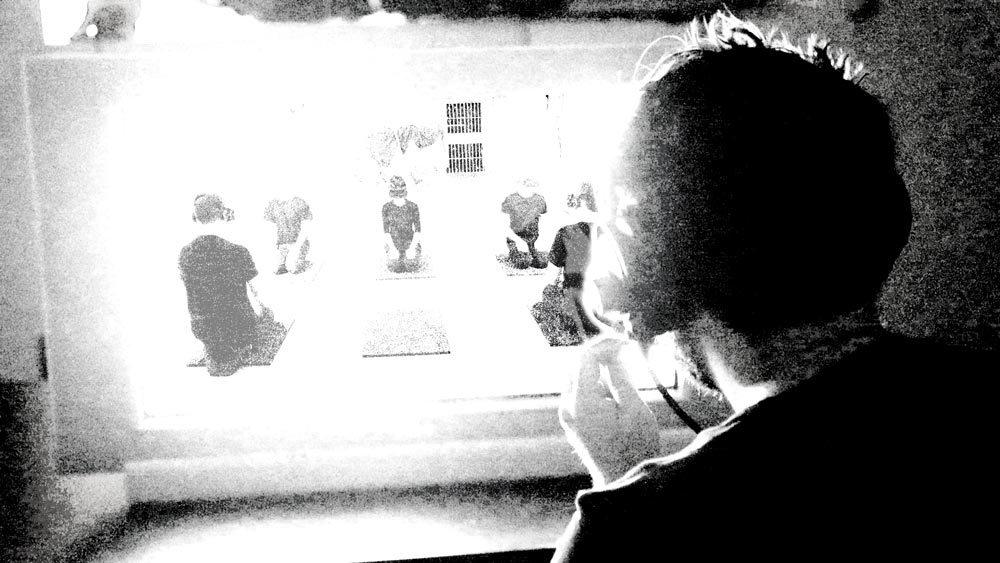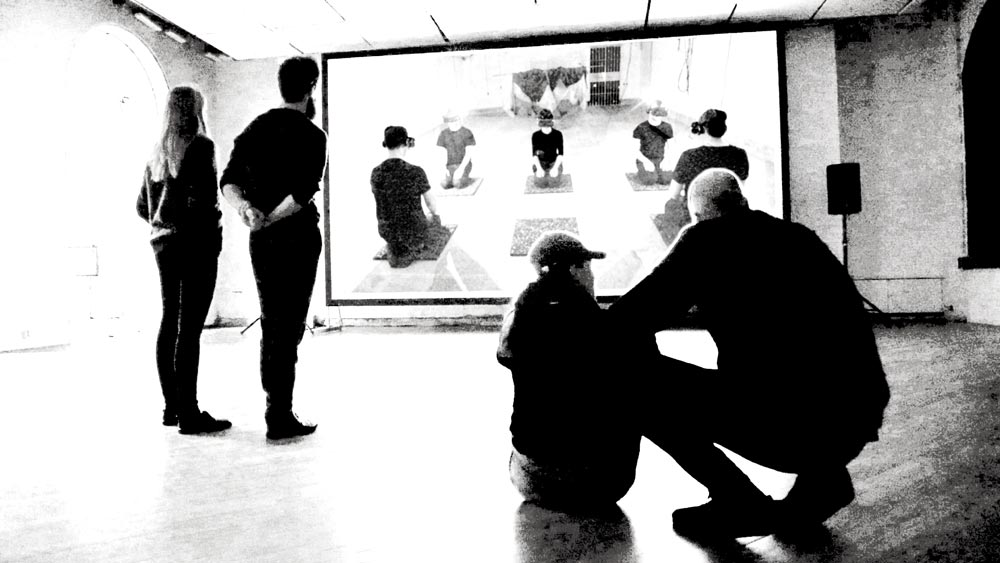CONTROL is a participative installation dealing with topics of control, intimacy and virtuality. In a VR-like setting the audience moves through different stages in an empty building while using first-person-perspective surveillance technology to experience the setting both in a virtual and an immersive context. Through the use of wireless video-cameras the audience is put into positions of control and obedience. The resulting setup has qualities of a VR-world,
a computer game and a hierarchical organization. The audience has to decide how to communicate with one-another and how to react to the scenery. It evokes as opposing reactions as togetherness, intimacy, fear, hierarchy, humor, confusion and excitement. The experiment-like setting allows for a rich palette of human interaction and depicts social and technological aspects of an artificial and systematized world.

Technical
Setting
The audience undergoes the concert installation in three phases. All phases have a length of thirty minutes, thus the whole piece has a duration of 90 minutes. Every thirty minutes a group of four new visitors will enter the installation and the previous visitors will move to the next stage.
1. Main Setting
2. Control Rooms
3. Surveillance Room
The first phase begins with the visitors entering the building. Here they are given modified VR- glasses. These goggles are equipped with a wireless camera, microphone and headphones. The visitor sees through the glasses and perceives his actual surroundings, but the technical equipment streams his/her perception directly to the Control Rooms. This way, every visitor is linked to one Control Room.
The person sitting in the Control Room sees and hears exactly what the specific visitor perceives. The visitor receives orders from this Control Room, and is told where to navigate and how to interact. There is no clear set of rules and the events of the main setting develop differently each time.
After thirty minutes the second phase starts and the visitor enters a Control Room. Here the participants now have the possibility to instruct and guide one of the new audience members. They monitor the visitors’ camera view on a screen and hear the sound on a headset. They are now be able to issue orders to the connected participant through the microphone.
In the last phase, the participants enter a Surveillance Room from where they oversee the whole situation from an external perspective. In the third phase they are spectators with no further involvement. They can choose between different camera angles, which allows for a multi-perspective narration.

Virtual
World
The piece fundamentally circles around the topics of virtuality, hierarchy, intimacy, system organization, surveillance and modes of perception.
The basic setup resembles both a technical and a sociological component. From a technical point of view the setting appears like a computer game or a virtual reality simulation. On a social level the piece deals with the creation of a system which allows the establishment of rules, control and surveillance.
The computer-game-like world that is created in the building has a hollow and abstract feel to it. The almost complete absence of speech and minimalism of interaction and performance underlines this sensation. The different rooms and performers do not deliver a theatrical or staged performance but rather evoke and offer a setting to interact with. There is no plot or backstory for this work: it is not trying to tell a story. It merely offers a space to evoke different forms of encounters.
The anonymity plays a central role in this approach. Both participants and performers are masked with VR-glasses and are hence depersonalized. The fact that the visitor only communicates by voice to the Control Room also establishes a highly abstract scenario.
The hollowness and also scariness of the setting often leads to a collective thinking and the wish to support each other. Still a sense of control and confusion maintains throughout the work.
All interactions have highly ambivalent connotations in the installation and range from fear, surprise and pity to empathy, intimacy and bonding. The switching between these perspectives is a core part of the piece. The different forms of perception are facilitated as well through the different phases of the installation work. The audience has the chance to perceive the same setting three times in a row: as a visitor, as a controller and as an observer. Each phase creates a completely different form of engagement and closeness to the setting. Of interest are the questions how quickly we adapt to the setting (may it be direct or virtual) and in which setting do we allow ourselves to be immersed and engage emotionally. The setup is meant to reflect the question what is needed to emotionally bond and also how we are able to see through the eyes of someone else. How do we want to control this body and how much do we take over their perception (and feelings)?

Systematic
World
Not only is the installation a mirror of an increasingly virtual world but also depicts a closed system with certain rules and mechanisms. The audience enters the building with no prior information on the scenario whatsoever. Also the fact that the controllers are previous visitors is not communicated. The layout and structure of the work has to be understood throughout the process. The piece is designed to make this a difficult task, and there eventually is no plot or story to decode. The clean system and its synchronicity and communication setup is its sole purpose and content. In many aspects the setting resembles an experiment in which the participants can choose how to behave and interact.
There is no wrong and right. If someone wants to stand still for thirty minutes then that is possible. Despite obvious exit strategies there are also no rules for the Control Rooms. So whether the form of communication is tender, earnest, dominant or cooperative varies from case to case. As the audience step by step moves upwards in the system and gains control progressively it can be seen as a social or capitalist metaphor. In any case it’s a constructed system which provokes the necessity to position oneself. The role of light and music in this context are facilitated in order to establish a state of synchronicity and connectedness. The setting appears to follow a set of rules which are basically impossible for the visitor to decode.